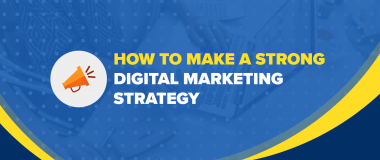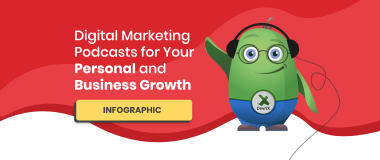One of the most essential issues in advertising is that many marketers find it hard to meet metrics-measured results. According to HubSpot, the most significant challenges for marketers are generating and converting leads, proving ROI, using the right technologies, targeting consumers, and managing their website.
All of these goals are based on meeting specific metrics-measured results like cost-per-lead, CAC (Customer Acquisition Cost), bounce rate, and growth in engaged audience. If you’re failing at achieving the needed results, using the same methods other marketers are implementing in their campaigns, you most probably are counting on some overrated marketing practices.
To help brands have a thorough, effective content strategy, we have decided to point out some common mistakes, show you how to spot the problems they cause and resolve those problems efficiently.
Pop-ups Asking for Consent to Opt-in
We’re placing this marketing practice first, as marketers often block users from reaching the content on a website with excessive pop-up usage. In most cases, companies view this as one of the most effective ways to gain consumers’ consent for cookie usage or email list building.
The pop-ups timing and implementation however often go wrong. Often that is not allowing the visitor to get acquainted with the website first or is irritating the user with a high frequency of displaying the pop-up or too many pop-ups altogether. Companies are asking the visitor to perform too many clicks before they can offer something in return to justify those clicks, thus their conversion rate actually goes down.
Although you’re directing the attention of the user into giving you consent, this method can be slightly irritating. You simply can’t expect visitors, who’ve just encountered your brand for the first time, to sign up for your newsletter before they have been properly engaged by your content.
Furthermore, users see premature pop-ups as a way to get their data rather than being a trustworthy source of information. They have the feeling that you’re trying to trick them into something right from the start and look at your content with more caution. This is why such ads could result in higher bounce rates.
One of the most important things to do when you are putting to use such marketing practices is to think of the user’s journey and keep in mind that your audience is searching for specific content, delivered at the right time.
Even if the user is engaged by your content and finds it valuable, if a pop-up ad that has nothing to do with that content appears in the middle of an article, you are not helping by providing more of that content at the right time, but are distracting the user,disengaging him/her and opening the door for them to leave your website.
The bumpier the user’s journey is, the harder it’ll be for you to make people respond to your call-to-actions (CTAs) and choose to become your clients during their consideration process. The competitiveness in many industries is so big that the smallest negative impression could build up to catastrophic results.

GDPR-Compliant Cookie Policy Message via Salesforce.com
To fix that, there’s a simple, proven method, use sections for newsletters or non-irritating sticky messages for cookies, which let the consumer move through your content seamlessly, and easily navigate back to give your content.
This way you’ll be able to not only provide a more memorable user experience, but you will also appear as a trustworthy source of helpful information, rather than a random website looking to use personal data.
Paid Advertising
Very often in paid advertising, marketers reach too broad of an audience or not the right audience at all. It is extremely hard to reach the precise audience when it has not been engaged with your content already.
Because of a lot of trial and error, marketers are quick to decide that paid advertising is not working for them altogether, instead of being consistent with their chosen strategies. There are a few factors, stirring the waters in paid advertising:
Overlapping your audiences with those of competitors
One of the most essential principles in marketing is to understand who your potential client (buyer persona) is, what their goals and interests are, what their set of beliefs are and how they measure success.
Furthermore, it’s essential to know at what stage of the buying cycle they are – is this their first encounter with your brand or do they already know you and are comparing your service/product to your competitors’?
Targeting small but very precise groups of people based on their psychographic characteristics will allow you to slash through the commonly used market segmentation and reach your potential customers who, hopefully, have not been already converted by competitors.

For example, your brand might be offering high-quality hip-looking backpacks for an urban environment. Of course, reaching out to high-schoolers and their parents is probably the first thing that comes to mind. Though, you may also have a higher-income audience with substantial demand for such products such as, tech professionals, and office personnel that use bicycles or city transportation and need to carry their laptops.
Furthermore, there may be a trendy company offering similar products that does not deliver to your region. And thus, you could target local people that are already interested in such a product, and reach exactly your buyer personas at a comparatively small cost.
Reaching brand new audiences each time, without engaging with them or using remarketing ads
First of all, when you’re reaching new prospects, you have to be ready to answer their needs through your content, services, and products. For example, if you’re targeting C-level professionals and offering marketing services, there’s no point in explaining simple concepts such as why a brand needs to advertise and have a content strategy in place.
Such information is already known to your buyer personas. Offering novice-level content to highly experienced professionals will lead to lack of trust from your audience, costly campaigns, and minimal results. To provide intent-based content, you have to understand your audience, its interests and problems first.
Furthermore, you have to always think of the buyer’s journey and ways to move them down your marketing funnel. One of your primary marketing goals is to convert viewers into leads. This is why it’s important to always leave a way to reach consumers who already viewed your content and were engaged by it. Remarketing is becoming much more challenging under the new General Data Protection Regulation and now requires explicit consent by all EU users outside of social media channels.
The most effective methods to re-engage your leads are through newsletter sign up sections, cookies, push notifications, video remarketing (social media, Google), CTAs provoking a particular action, e.g. “Register to try our product 30-days free”. Gaining consent through such channels could make it easy for you to remarket content specifically tailored to the needs of those people with the aim to convert them to clients.
Not setting the right event trigger to track your conversions
This is among the most harmful marketing mistakes that could lead to costly leads and money spent with no actual results. Setting the right events that show a conversion would help you to avoid reaching individuals that were already acquired as active leads or clients. This approach will also significantly reduce the cost of your campaigns and help you appear as a non-spammy, trustworthy source of information that respects its clients.
Pro Tip: Keep in mind that any advertisement has its life cycle. This said, if a consumer is not engaged after a certain number of times viewing an Ad, they’re most likely never going to click it, or even if they do, they’re most probably not your buyer persona in the first place. This is why it’s good cost-reductive practice to exclude such people from your campaigns and polish your content strategy and targeting methods along the way.
Social Media Marketing (SMM)
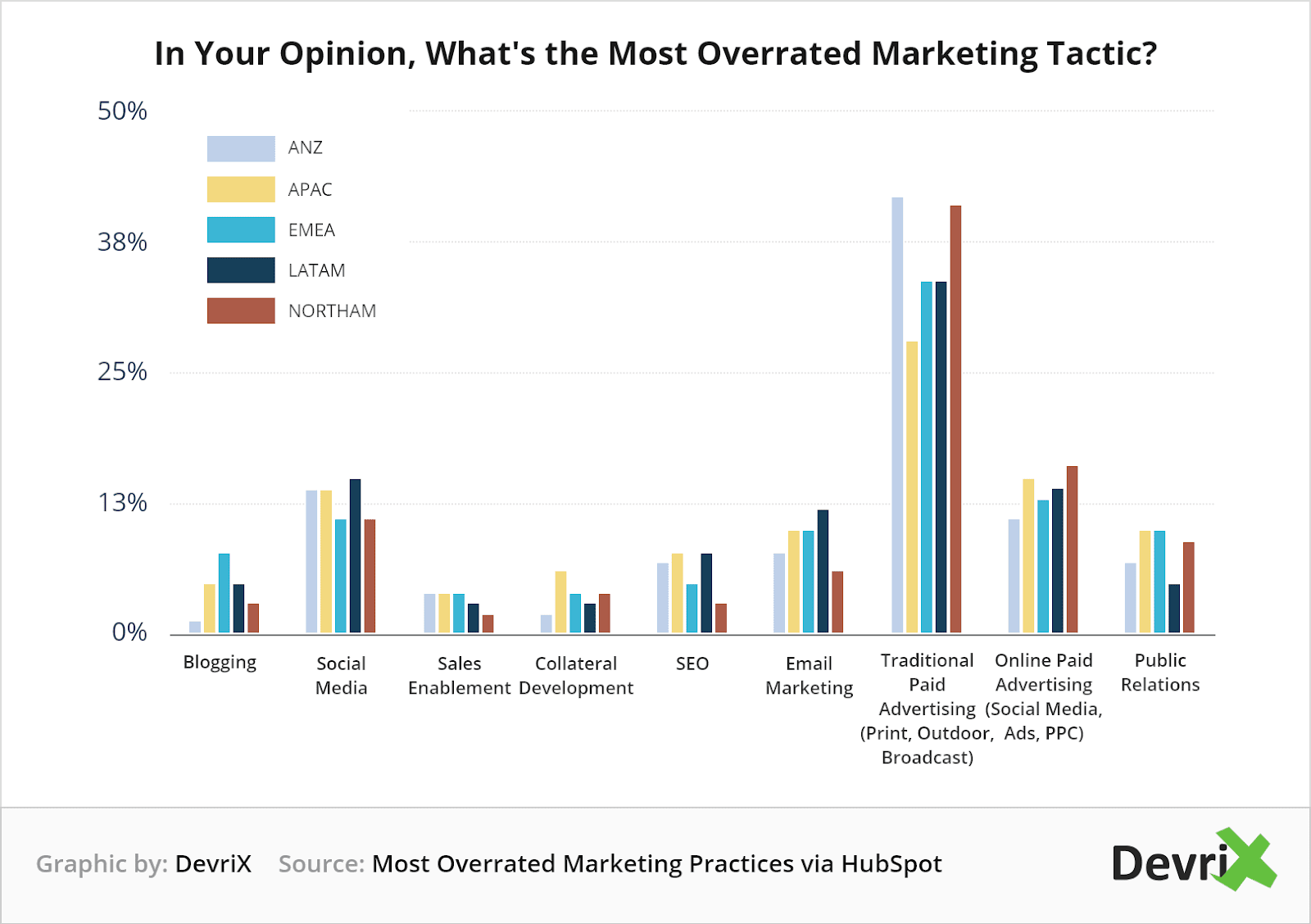
According to HubSpot, SMM is among the most overrated marketing practices. Many marketers complain that either the paid advertising doesn’t engage their desired audiences or that the organic reach doesn’t drive up results.
First of all, you have to think of social media as a matrix of different communication channels. In other words, you have to keep in mind what the goals of your content strategy are and align your paid campaigns and social media content to work coherently to achieve the desired results.
Let’s say your final goal is for the consumer to purchase software products from you. Publishing a video, explaining how the product works and boosting it to reach more people, would gain you both an engaged audience and some additional page likes that will come from people who’ve enjoyed your content.
An easy way to keep the audience engaged is to publish articles explaining potential problems that were resolved by the product, comparing it to competitors, listing key benefits, presenting clients’ testimonials. This way you could both monitor what content works best with your audience, help them take an easier decision in the consideration process, and move them down the funnel.
Finally, after you have an engaged organic audience and specific target groups (a substantial number of people considering whether to become your clients), you could deliver a precisely-tailored ad, leading to a decision provoking landing page, convincing users to purchase the product from you.
Pro Tip: One of the most essential opportunities that social media presents marketers with is the ability to monitor and listen to the conversation in such networks. Gathering information about your audience, marking potential problems, listening to feedback and understanding competitors’ mistakes could help you gain substantial insights about the market, special opportunities and your buyer personas as a whole. This data could help you polish your campaigns, target more specifically, offer highly engaging content for the users, present real solutions to real problems, and stand out from competitors.
Email Marketing Mistakes

Email marketing can be a champion of the overrated marketing practices, when not done properly. It’s often taken as the easiest thing to do in advertising and thus the focus and efforts marketers put into it come short and do not drive the desired results.
As with everything else we’ve mentioned previously in this article, the easiest way to turn your email list into a powerful lead-converting tool is by constantly thinking about your user’s journey. Doing so will guarantee you higher email deliverability and response.
Every one of us gets those emails we don’t read because we don’t have time, the ones that go in the junk folder, the clearly spammy, or the fakes. But what makes users choose which emails to open and which ones to skip? What will cause your newsletters to land directly into the spam folder? These are the questions you should be asking yourself in order to fix the failures of overrated marketing practices in email marketing and guarantee yourself effective email campaigns.
First of all, work with leads! Forget reaching consumers that are not engaged with your brand and haven’t signed up to your newsletter. Reaching those people will only result in higher bounce rates and hurt your domain reputation. Moreover, if a few months back this was a widely used practice, now, under GDPR, we’re all bound to work only with people who’ve given us consent to collect, store, and use their personal data (e.g. email address).
The easiest way to gain the agreement from such users is through newsletter sign up sections and registration forms. Just make sure to have two crucial types of checkboxes. The first should be stating that the user gives you consent to collect their data. The second checkbox should explain what the data will be used (e.g. “Sending weekly newsletter”). It’s also a good place to include a way through which the user could indicate topics they’re interested in.
This will help you create more personally tailored campaigns and thus have a higher conversion rate. Also, ensure the user is providing you with a real email address and not a “spam trap”, sending even the smallest amount to such emails automatically marks the sender as a spammer for various email service providers. You could avoid this by requesting an email verification.
From then on, it’s all about sending valuable engaging content and not getting reported for spam. Having such reports, as well as various other factors, could get you blacklisted which will block your ability to send emails for a significantly long period, as they’ll automatically go in the junk folder of email services providers.
If you want to go out of the dreadful prism of overrated marketing practices and ensure high engagement rates, you have to deliver valuable content based on the data you have about your buyer personas.
How to Fix Them
That being said, there are a few proven, effective hacks to turn your emails from an overrated marketing practice into a lead-converting one:
Send Emails from a Person, Not from a Company
Receiving an email from an actual representative of the brand always feels way more personal. Furthermore, one of the first things we do when we go to our inboxes is to skim through all the emails we’ve received and started answering the ones that matter. Seeing an email from a brand will make our subconscious focus less on it and more on the ones from people that need a faster reply.
Even if you decide to send e-letters from your brand’s email, do not make it a [email protected]. Using such an address is practically saying to your customers you don’t want to receive their feedback and don’t want to continue the communication. This could resolve in catastrophic results, disengagement, and lack of trust from your audience.
Personalize Content
First of all, you’re writing to actual people and expect them to act in a particular way to move them down the funnel, so drop the too formal business talk. It’s always better to address people directly and show your more personal side, especially if you to trigger an action on their side Moreover, as we’ve mentioned before, it’s a good practice to send people the information they’re interested in and absent from other emails.
To achieve this, it’s essentially helpful to allow users the opportunity to check which topics they want to receive emails about. This could be done through checkboxes on the newsletter sign-up section or a web form, as well as by updating such information later on, so ensure your subscribers have an easy access to their email preferences!
Design Platform-Perfect
According to Bostinno, 48% of emails are opened on mobile devices. This means that you have to ensure your emails look perfect on all possible devices – PC, laptop, smartphone, tablet, etc. This approach will help you reach more people and deliver an exceptional user experience to all of them.
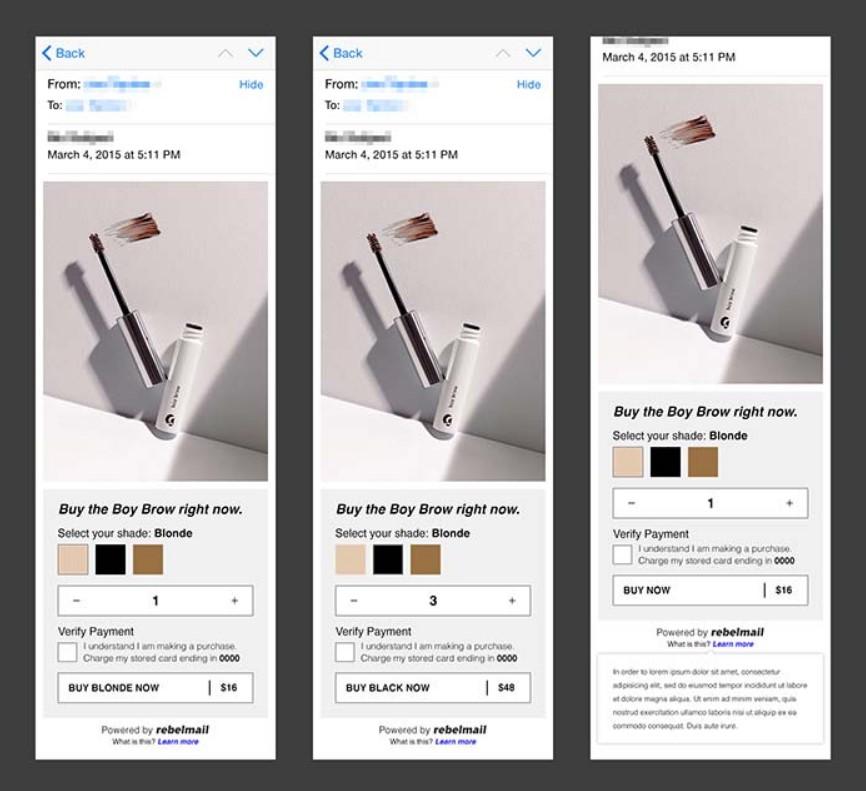
Interactive Email via Rebelmail
Interactive Experience
Give consumers something more that will stimulate them to actually engage with the email you’ve sent. Interactive emails, offering the options to embed videos and pictures, drop-down menus, and call-to-action buttons are a great way to attract the attention of consumers and present personally-tailored content. According to MediaPost.com, interactive emails increased unique clicks by 18.3% and click-to-open rates by more than 10% when compared to non-interactive messages.
Craft Compelling Subject Lines
According to Cmbinfo.com, 47% of users decide whether to open an email based on the subject line. Basically, subject lines are like CTAs – they have to engage the user and urge them to open an email. This is why they have to be concise, to-the-point, clearly stating what’s inside, non-misleading, and based on action-oriented verbs.
For example, “A Course for Marketing Specialists” is both too vague and doesn’t imply any response. Whereas “Enroll in the world-famous course for inbound marketers” both calls to action, gives information about the course and present who is it aimed for. Furthermore, stating a familiar sender name will help consumers view you as a trustworthy source and open your emails more.
Another useful trick is to add personalized tokens, such as the name of the recipient. This customer-tailored approach will help your emails reach an even broader audience. There’re many useful tools that will help you significantly to craft non-spammy effective subject lines like SubjectLine, Email Subject Line Grader, and Headline Analyzer.
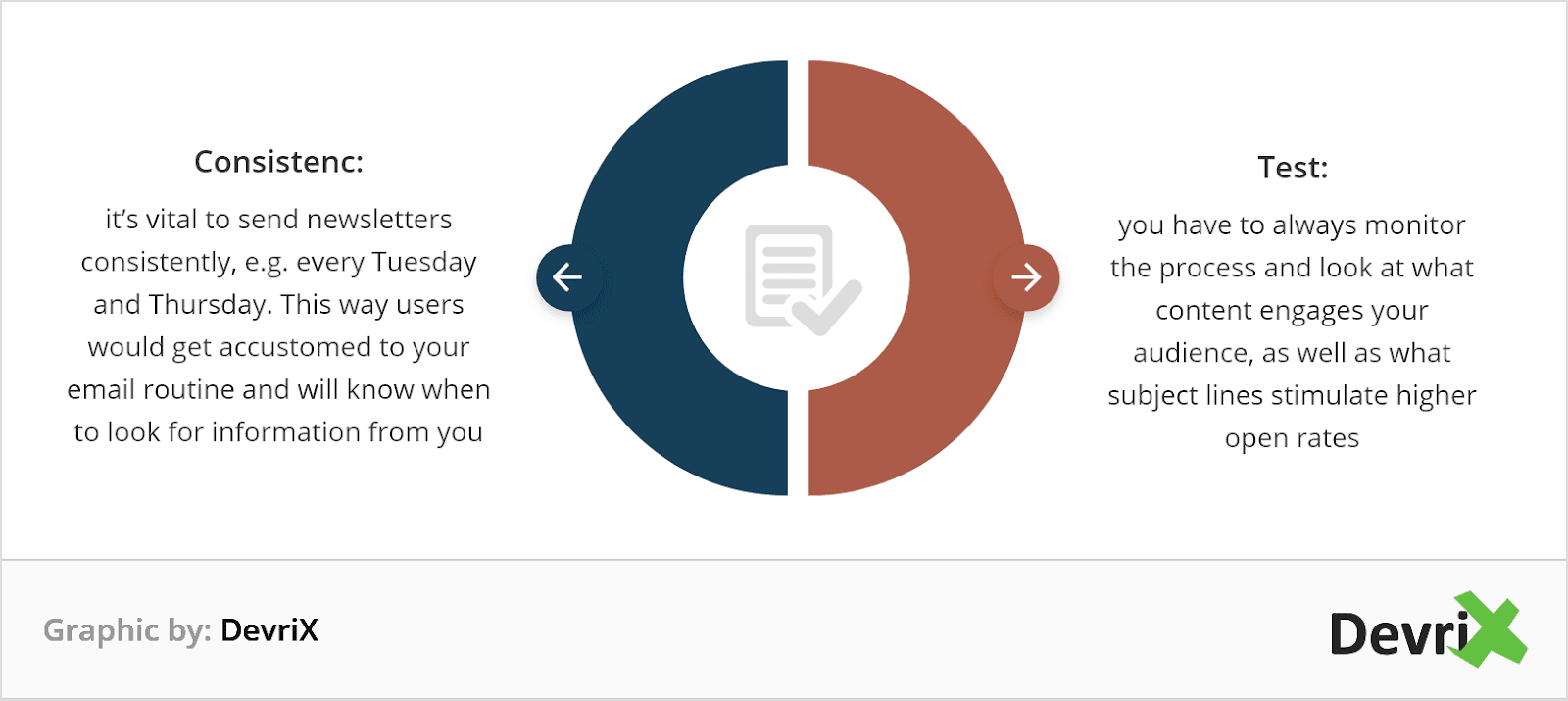
- Consistency – The best way to ensure your emails are going to be opened is if a person is already expecting them. This is why it’s vital to send newsletters consistently, e.g. every Tuesday and Thursday. This way users would get accustomed to your email routine and will know when to look for information from you, thus stimulating higher open rates.
- Test – Email marketing is a constant process of polishing your practices and content to drive up results and convert leads. This means that you have to always monitor the process and look at what content engages your audience, as well as what subject lines stimulate higher open rates.
Email marketing might be among the leading overrated marketing practices as tiny details could be responsible for its ineffectiveness. To make it work for our goals and drive up results, you have to base your emails on the information you have about your audience, follow latest market trends, be consistent, and offer users valuable information!
Online Presence
All brands are aiming at being known to the digital community. Yet publicity could have both negative and positive aspects and it seems like a lot of companies are forgetting this fact. Investing in awareness is great but speaking purely from “what we do and how great we are” perspective will get you nowhere. Instead, try to think of the user’s journey and view things from their own eyes.
This said, communicate what you can give your audience, why your brand needs a community, what it aims to achieve social-wise, what are your ideas, goals and mission, what differentiates you from competitors as a unique user proposal. All these things will help your users see the value of your brand and align with your company’s goals to gain personal benefits and help affect society in a positive manner in the process.
If you want to reach consumers on a personal level and gain a substantial online reputation, showing only the practicality of your services and products won’t do the trick. You have to present your unique image and tell the story of who you are without underestimating your audience. People browse the Internet on a daily basis and rewriting the same story they’ve read a hundred times is not enough. You have to add value by speaking from your own experience and integrating your principles and believes in your content.
Furthermore, you have to really know your audience and answer their needs. Your brand should present key differentiators and unique value propositions to stand out from competitors. Otherwise, you’re going to generate leads that you’ll lose at the consideration process when they start comparing you with other brands because they won’t be able to see your value if you don’t present it directly.
Keyword Stuffing
Even today, many marketers still try to make their articles stuffed with keywords. However, SEO optimization has become a much more elaborate process, as search engines are constantly developing and growing “smarter” each day. More and more users are starting to adopt voice search which affects SEO even more as written phrases are usually different than spoken ones both regarding length and structure.
To explain the concept further, just think of how texts are created as a structure. All words in a written material are semantically connected to each other and give the logical meaning of your content. Search engines are now acknowledging this fact and using it as a criterion for your ranking – Latent Semantic Indexing (LSI). This said all words in your text are connected to the focus keyword(s). This helps search engines understand the topic of your article and rank it accordingly to ease people searching for the keyword(s) in the exact context you are using it in.
For example, “AR” could mean both Augmented Reality and Accelerated Reader. So if you’re using words like “books”, “reading”, “schools” it’ll help search engines understand the context in which you are using the keyword “AR” and will rank you higher for searches related to Accelerated Reader and lower for searches related to Augmented Reality.
Moreover, Google uses artificial intelligence with learning capabilities, to ensure search results are based on the intent of the search. If you’re searching for a local supermarket by its name, the search engine will display the closest location or product page higher than the “about us” or “headquarters address” because it’s more likely that you’re searching for a store near you than for a corporate description. This is done to ease consumers and adopt a more personally-tailored approach.

To attract more viewers you have to offer thorough content on a particular topic. In our case, the materials are focused on “web development “ and “inbound marketing” as we’re a brand that’s offering such services. But within this topic, there can be thousands of searches, so it’s important to offer various content that will help us appear in the results of more consumers, and thus reach a larger audience.
To properly craft a similar content matrix you have to understand your audience and come up with ways to deliver valuable, engaging information to people in different stages of the buying cycle and relevant to the keywords they’re using in their searches:
Informational Searches
Common for people in the awareness stage of a buying cycle, such searches intend to acquire information about a particular topic that is explained on multiple websites. Similar searches are “NY rent prices”, “top smartphones”, “choosing a kindergarten”.
For these searches, use words that build trust and show your article is examining and explaining the topic better like “Top X tips”, “Essential”, “Hacks”, “Helpful”, “Effective”, “Cost-reducing”. The trick is to make your headline answer to the user’s intent (find a solution to/information about a problem.) This approach will help you appear as a trustworthy source in the eyes of consumers and will lead to higher engagement rates.
Navigational Searches
These type of searches are most commonly used by people that are already your clients or are comparing you with other brands. Keywords include phrases like “DevriX services”, “Twitter’s Policy”, “Blizzard Log in”. To ease consumers, you have to make sure your pages are highly ranked in such searches, especially if they include your brand’s name.
It’s also advisable to introduce your key differentiators (e.g. price, ease of delivery, 24/7 support) on all possible pages to help consumers at the consideration stage see your unique value and remember it.
Transactional Searches
The aim of these searches is to perform a purchase or activity that the user has already considered and decided upon. Keywords like “coupon”, “discount”, “free trial”, “shipping”, “best/top” are commonly searched for in such cases, so adding them in your website will help you rank higher and reach more prospects.
Even though keyword stuffing is now a punishable practice by search engines, a keyword density of around 0,5-2,5 % is considered optimal. What’s effective concerning ranking and consumer engagement is to use headers and sub-headers. It’ll not only help search engines understand the topic of a given page better, but this practice will make it easier for customers to navigate around and focus their attention on information that is interesting and helpful to them and thus become engaged in your content. However, keep in mind that using keywords in the headers may help you rank even higher.
To help you in the process of optimizing your content for SEO and turning overrated marketing practices into lead-generating ones, there’re many useful tools out there you can use like Google Keyword Planner, Google’s auto-suggest and related searches features, Neil Patel’s Ubersuggest and SEO Analyzer, Ahrefs Competitor Research Tools, and SEMrush Advanced SEO toolkit.
Such tools can help you select the right keywords, see how difficult it’ll be to rank for each one and how many users are using it in their searches, and discover valuable insights into consumer behavior regarding your industry.
As your website is a gateway to your brand, SEO optimization is basically among the most important things to consider for a successful lead generation. Ranking higher will help you reach a broader audience. However, to do so, you have to acknowledge the fact that search engines are now smarter, intelligent and learning, so you have to base your efforts on users’ intent, interests, behaviors, and beliefs. This way you’ll be able to reach exactly the people that are your buyer personas.
Fake Reviews
Nowadays, consumers are using countless websites that offer brand listings and ranking by industry and user feedback. This is why many companies have started using fake reviews as a method to gain a positive reputation, appear among the top results and appeal to more users.
This approach may seem like a harmless way to lure users into trying your products, however, fake reviews could be quite easily spotted. They usually feel non-organic, are written well, too much like an advertisement, and are regularly suggesting that others need to try the products/services. Keep in mind that if discovered, your profile could be deleted from several rating sites such as TripAdvisor, Yelp, and Amazon Customer Reviews. This would affect your reputation and lead to lack of trust by the audience.
Furthermore, let’s imagine a user has read a review stating that a particular restaurant offers “outstanding service and amazingly tasty, bursting with flavor Mediterranean cuisine”. Everything sounds great, so the consumer books a table and goes there to try out the experience, only to find the review couldn’t be further from the truth.
On a psychological level, feeling tricked into doing something will most probably trigger a consecutive reaction from the person – e.g. negative review, angry status in social media, retelling the misfortunate story to friends. Meaning, that fake reviews could extremely easily fire back at you at some point and literally destroy your reputation over time.
Ignoring Negative Feedback

Ignoring Negative Feedback, Image via Bustle.com
Just as there are positive reviews of our brands and people that are satisfied with what we offer, there will always be negative ones as well. Many marketers think that ignoring negative feedback will affect their reputation better than answering it. However, consumers talk, share, influence others, recommend, and comment.
If a story about your brand ignoring feedback and consumers’ problems becomes public, this could actually make consumers view you as a company that doesn’t respect them and is just looking for profits. At this point, you would have created a crisis you can’t control out of a desire to run away from a dispute or uncomfortable conversation. With time, this could lead to a significant lack of trust in your brand, decreasing revenues and a skyrocketing cost-per-lead.
Furthermore, there’s a reason many brands are working with influencers – such people have their own audiences and could make you go from zero to hero within a month. Although you’ll know a lot of them, you can’t be entirely sure though that the person whose feedback you’ve ignored is not an influencer. Even if their profile on Facebook might have 200 friends, their Instagram may be followed by thousands. Precisely the way these people are promoting brands, they can as easily destroy your reputation with a single social media status, engaging their audiences.
On the other hand, there is feedback that is way too demanding and unrealistic in terms of expectations. For example, if you’re offering an SEO optimization tool, have a free trial, and a person is still complaining about “not being able to use the software for free”, that’s pretentious. However, instead of leaving their request unanswered, try explaining that you have a free trial where users could test the product and decide whether they want to buy it or not.
It’s crucial to review complains objectively and answer them promptly, following up with solutions, apologies, and even compensations when the consumer is actually right. This approach will help you leverage negative feedback, fix potential problems and come up with reputation gains out of the whole situation. It’ll also let you understand further what consumers need and think of ways how you can deliver. A good practice is to also monitor negative (and positive) mentions online, and treat them as complaints to spread your influence and online presence.
Pro Tip: An extremely helpful practice to reduce negative reviews is to have a “negative persona” profile. Similar to the buyer persona, who is your ideal customer, the negative one is precisely the person you don’t want as a client – your services and principles will not appeal to them. Gather information about these people and exclude them from your campaigns. Reaching them will only be a waste of resources.
Outbound Marketing
Nowadays, people are all “plugged in” the digital world almost all the time. Even when they walk, they’re usually listening to Spotify, going through emails, browsing social media or reading something. This is why the king of overrated marketing practices is outbound advertising. It doesn’t take into account who people are and what they do and tries promoting stuff to them using methods that don’t provide value in order to attract their attention.
Diving deeper into the topic, the cost is just as big because you’re reaching an incredibly large amount of people (for which you’re paying) without knowing who will love it and who will hate it. This way, you’re for sure building reputation, but whether it’s negative or positive is left at the odds. Gambling your whole brand and life work for a campaign, is not advisable, at least not by any PR expert.
Due to the high market competitiveness in almost all fields, we’re literally bombarded with advertisements on a daily basis. To make an ad attractive, you have to present your consumers with content that is specifically tailored to their interests, goals and needs. Otherwise, your efforts will simply get lost in the marketing mix.
So, what’s the solution, you’re going to ask? Well, have you heard the expression “How can we make this outbound marketing practice more inbound?” Working with leads, using the information you get from them to craft content specifically for your buyer personas, reducing costs by reaching small precisely targeted groups, and using data to drive up results, is the answer to your question.
There’s a reason marketing giants like HubSpot, are addressing the time we live in as the era of inbound marketing – because it provenly works!
“Salespeople exist to discover where desire is and then deliver on that desire.” -Seth Godin
Don’t Fall into the Trap of Overrated Marketing Practices
Many advertising methods will cost you a significant amount of resources for little to no results. This is due not because such practices are ineffective, but because they are done the wrong way – without understanding the market and consumers.
As inbound marketers, we at DevriX, acknowledge the fact that people are looking for more valuable and precisely-tailored content. We’ve created this guide to offer you the right approaches to using some of the most well-established marketing methods. Always think of who your services/products are aimed at.
Put yourself in your customers’ shoes, personalize your content and service, offer a unique journey that will touch the viewer on a more humane level, that will excite and intrigue them. Create experiences that provoke who we are as humans, bring value for your customers, and enrich the world around you!


